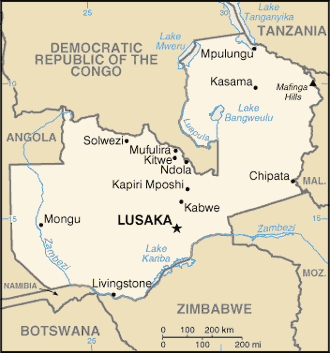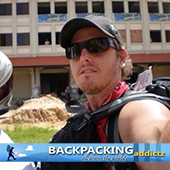- Population: 11 million (UN, 2005)
- Capital: Lusaka
- Area: 752,614 sq km (290,586 sq miles)
- Major language: English (official), Bemba, Lozi, Nyanja, Tonga
- Major religions: Christianity, indigenous beliefs, Hinduism, Islam
- Life expectancy: 38 years (men), 37 years (women) (UN)
- Monetary unit: 1 Kwacha = 100 ngwee
Backpacking in Zambia
The Republic of Zambia,South of Africa, is all about the “natural African high”. With no mention of drug or secret chewable leaf, Zambia’s breathtaking sights and sounds can elate one’s state of mind sans ingestion and injection. Most African offerings of safaris are seemingly one and the same, and hopefully such a statement won’t be taken as intent to relegate Zambia or Africa. But, everyone talks about an iconic and authentic African safari from Kenya to Tanzania. Zambia, fortunately may just fit the bill.
This is the land of lakes, falls, and rivers that can intimidate an unsuspecting spectator. After all the Victoria Falls is one of the world’s top tourist destinations, and many tourists indeed prefer to have the Victorian experience than any Africa’s got to offer. My point earlier, the Victoria Falls – see it in Zambia or Zimbabwe? Nevertheless, Zambia attracts visitors through its wide range of avant-garde options of the Must-Do here, the tourism board successfully picking up the pieces. How can it not with not less than 20 waterfalls in tow. Zambia could just be the wettest country in the whole of Africa, possessing the largest water resources in the continent.
GEOGRAPHY
Zambia (15 00 S, 30 00 E) is a landlocked country at 752,618 km2 that consists mostly of high plateau, hills, and mountains, with one too many lakes, falls, rivers and its tributaries. One-thirds of the country is preserved as ecological or national parks. The highest point of Zambia is an unnamed tip at the Mafinga Hills that is 2,301m high, and as nothing is below 329m above sea level, the lowest point is the river of Zambezi.
CLIMATE
Generally, the climate is tropical, albeit could also be dry and temperate depending on altitude. The country is mainly humid subtropical, with some patches of semi-arid climate along the Zambezi valley. Two main seasons, the dry season corresponding to “winter” and rainy season, to “summer” are during the months May-October, and November-April, respectively. Within the dry season are cool dry (May-August) and hot dry seasons (September to October).
PEOPLE
The current Zambian population is 12,056,923 that are 99.5% Africans of essentially more than 70 ethnic groups. This includes the groups of Bemba, Tonga, Chewa, Lozi, Nsenga, Tumbuka, Ngoni, Lala, Kaonde, Lunda, and some other minor groups. The remaining 0.5% includes Europeans, Americans, and Asians that are mostly Indian. More or less, 1.1 million people are living with AIDS, and in effect, 800,000 children have either lost a parent, or been completely orphaned. Life expectancy is 38.63 years.
LANGUAGE
Officially, it is ENGLISH that is used as the medium of instruction in schools and of conducting official businesses, amidst the 85 languages to choose from. Other official local languages include NYANJA, BEMBA, TONGA, LOZI, LUNDA, KAONDE, and LUVALE.
RELIGION
Christianity is the state religion, and is a kind of Christianity that remains to be intertwined with some traditional beliefs. Around 75% adhere to the Christian faith, and the others to Islam, Hindu, or traditional beliefs and practices.
ATTRACTIONS
In terms of natural riches, Zambia is quite the billionaire really. To be granted with so plenty of waterfalls and rivers for which it is greatly known for, is as amazing as having four wishes from the genie. Yet, all eyes and lights are on Victoria Falls of the Zambezi River, the star of the show. The Victoria Falls, a UNESCO World Heritage Site and one of the Seven Wonders of the World, draws all the tourist traffic in the Southern Province of the country. It also is, by some measure, the largest water fall in the world. The gushing of the water hitting the basalt gorges from a 100m-drop is pure power, and the colourful spectacle is spiritual. Never more will one feel a part of nature as in what seems the “Garden of Eden”.
But Zimbabwe shares the Victoria. Zambia’s upper hand is that it is less conflicted than Zimbabwe, in many ways more welcoming to visitors. In fact, you might as well expect a rainbow at one of the vantage points within that 1,600m spread of water, and that is not figuratively speaking. Given the Victoria Falls in the South is a spectacle, a search for other mysterious falls is an ingenious and adventurous idea. In the Northern Province of Zambia are a sundry of famous falls like the Kalambo, Lumangwe, and Kabweluma, but, there also are ones as incredible in the East Province and the West like the Kundalila and Ngonye, correspondingly.
And as water is integral to the land, normal attractions are given a twist. How about a safari along the river? Canoe safaris, river rafting, river surfing, and fishing make it as good as not having a beach in these parts, or make it as good as having one. I found Zambia amongst the best places for an educated wilderness safari, as they are truly high on environmental preservation too. One of the places where you certainly can tell they know what they’re talking about.
FOOD
As goes with food, Zambians know their cuisine and make it satisfying as it is appetizing. Traditionally, there’s the maize meal which they call nsima in Zambia as staple, or rice when maize meal is too becoming. For breakfast, it could be thinned and watered down to make porridge, or as a meal essential, thicker and rolled into balls. The nsima is then eaten with stews or relishes, ndiwo and umunani, which could be anything from smoked or dried fish or kapenta and other vegetables, or meats such as beef or chicken if accessible or afforded.
Fish are copious in this African country with the largest water resource. Grilled tilapia can do, one of the abundant freshwater fish which some already consider to be “pests”. But with tender meat and flavourful character, I’d say problem delightfully solved. Now, smoking or drying is a general way of Zambians with meat from beef to fish, which I found makes them more full-bodied. Typically, western food fare is also present, like burgers, fried chicken, pizza etc. that are just alright, not exceptional.
One knows not so well how to judge desserts in a famine-stricken country but Zambia actually is a great place to experiment with all the fresh fruits available. However, oddly they’re mostly potato-based, like golabjamoun, potato pudding, and biscuits. Desserts are not a requisite in an after-meal sense as in a lot of Western countries. Instead, they are of a festive nature. For the moment, dessert could be a fresh mango or some “tasty” buggers like moths or water insects. But, after smoked crocodile meat, I’ll pass on the bugs.
***
Backpacking in Zambia






Leave A Response